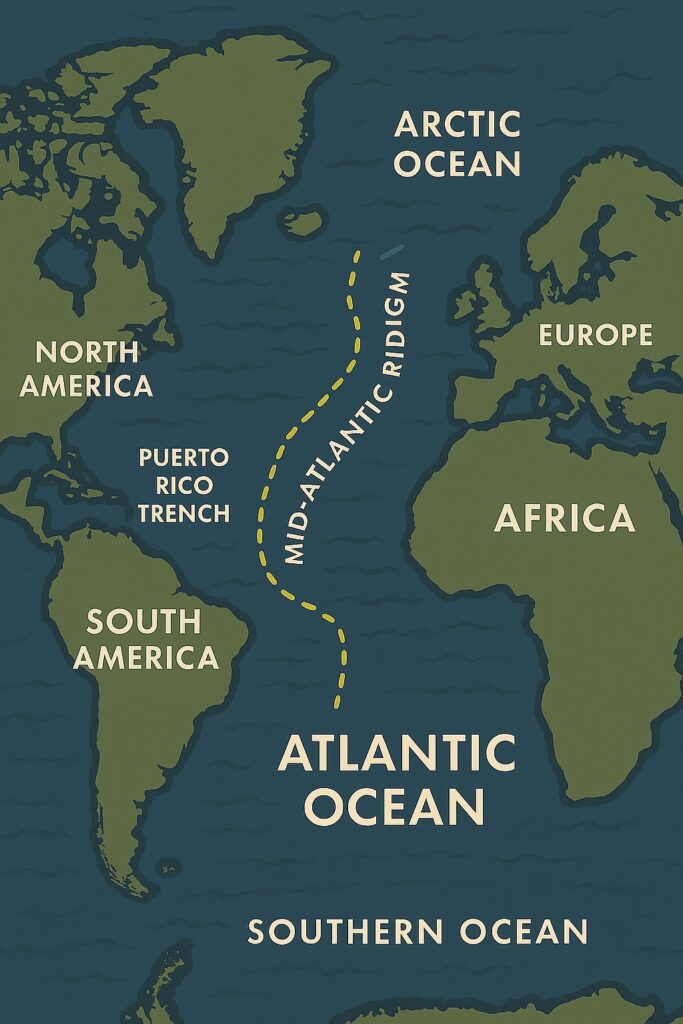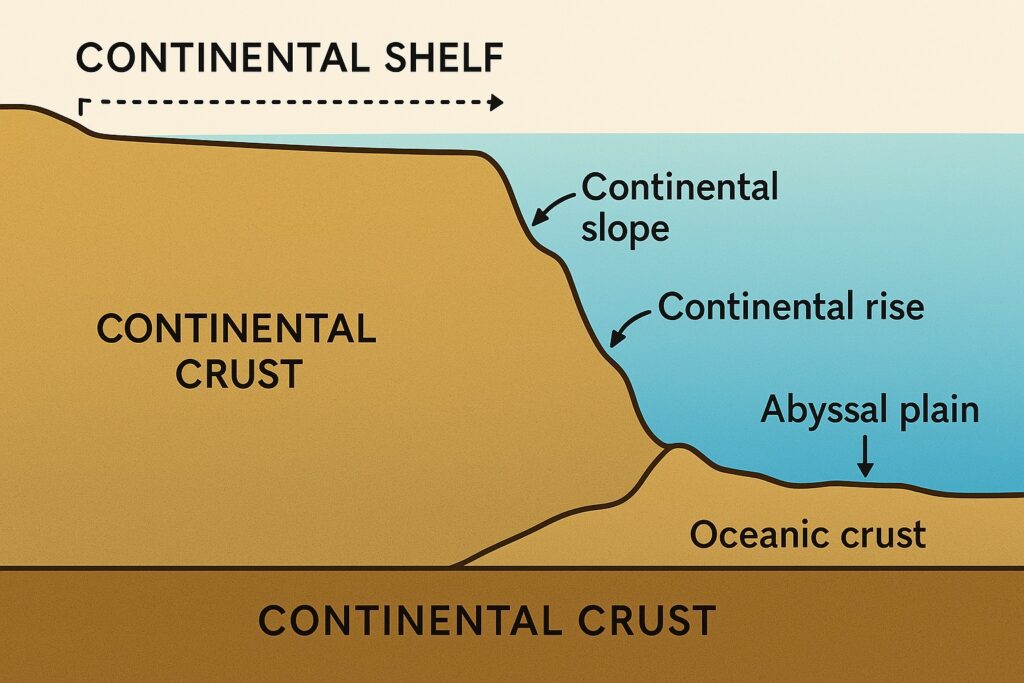The Bottom Topography of the Atlantic Ocean is shaped by a combination of mid-ocean ridges, abyssal plains, trenches, and seamounts. The Atlantic Ocean is one of the world’s five oceans and covers over 41 million square miles, making it the second largest ocean on Earth.

It is almost half of the Pacific Ocean in terms of area. The ocean floor of the Atlantic is a complex and dynamic environment, with a variety of underwater features that play important roles in everything from ocean currents and weather patterns to the distribution of marine life and the location of mineral and energy resources.
Table of Contents
Continental Shelf and Slope
The continental shelf in the Atlantic is relatively broad along the eastern coasts of North America and Europe, such as the Grand Banks of Newfoundland. The width of the continental shelf varies from 2 Km to 80 Km. The width of the continental shelf in the Atlantic Ocean varies due to several geological and tectonic factors. Areas receiving large amounts of sediment from rivers (such as the Amazon and Mississippi Rivers) develop extended shelves.

Regions with little sediment inflow or strong ocean currents that sweep away deposits tend to have shorter shelves. Further, Strong ocean currents erode shelf edges, influencing their width. The Gulf Stream in the western Atlantic has affected the shelf near Florida, making it narrow compared to the broader shelves off Canada.
Passive Margins (Wider Shelves)
- On the eastern coast of North and South America and the western coast of Europe and Africa, the continental shelf tends to be broader because these areas are along passive margins—where there is little tectonic activity and gradual sediment accumulation over millions of years.
- Examples include the Grand Banks (Canada) and the Argentine Shelf (South America).
-
These shelves gradually slope into the continental slope, which marks the transition to the deep ocean floor.
-
The continental slope is often dissected by submarine canyons, such as the Hudson Canyon, created by sediment-laden turbidity currents.
Active Margins (Narrow Shelves)
-
- Along regions with active tectonic boundaries, such as near Caribbean and West Africa, the shelves are narrow because subduction zones or faults cause steep continental slopes.
- The Puerto Rico Trench and parts of the African coastline near the Bay of Biscay are examples of regions with narrow shelves.
Continental Rise
-
Found at the base of the slope, the continental rise is composed of thick layers of sediments that have cascaded down from the shelf and slope.
-
This zone acts as a depositional environment and forms a gentle incline before merging into the abyssal plains.
Mid-Atlantic Ridge
The Mid-Atlantic Ridge is a massive underwater mountain range that runs down the center of the Atlantic Ocean, forming a divergent tectonic boundary between several major plates. It stretches from the Arctic Ocean in the north to the Southern Ocean near Antarctica. Key features:
- Tectonic Boundary: It separates the North American Plate from the Eurasian Plate in the north and the South American Plate from the African Plate in the south.
- Seafloor Spreading: The ridge is an active site of seafloor spreading, where magma rises from the mantle, creating new oceanic crust.
- Rift Valley: A deep rift valley runs along the ridge’s axis, marking the boundary between diverging plates.
- Volcanic Activity: Some parts of the ridge rise above sea level, forming islands like Iceland, which sits directly on the ridge.
- Hydrothermal Vents: The ridge hosts hydrothermal vent systems, supporting unique deep-sea ecosystems.
- The Mid-Atlantic Ridge plays a crucial role in plate tectonics, influencing oceanic circulation and geological activity.
- It is a divergent boundary, where the Eurasian and North American Plates (in the north) and the African and South American Plates (in the south) are moving apart.
- The MAR is the site of active volcanism and earthquakes, and in places like Iceland, the ridge even rises above sea level.
Ocean Basins of Atlantic Ocean
The Atlantic Ocean has several distinct ocean basins. Major ocean basins of the Atlantic:
1. North Atlantic Basin
- Located between North America, Europe, and the Arctic.
- Includes the Mid-Atlantic Ridge, which runs down the center, causing seafloor spreading.
- Features deep-sea trenches like the Puerto Rico Trench (deepest point in the Atlantic).
- Influenced by the North Atlantic Gyre, a major ocean circulation system.
2. South Atlantic Basin
- Spans between South America, Africa, and Antarctica.
- Mid-Atlantic Ridge continues through this basin, creating seafloor spreading.
- Home to the Brazil Basin and Angola Basin, which shape deep-sea currents.
- Influenced by the South Atlantic Gyre, affecting regional climate.
3. Argentine Basin
- Located off the southeastern coast of South America.
- Contains the Falkland Plateau and deep-sea plains.
- Strongly affected by the Antarctic Circumpolar Current and deep-water circulation.
4. Guiana Basin
- Lies off the northeastern coast of South America.
- Includes sediment deposits from the Amazon River, impacting marine ecosystems.
- Warm currents from the North Equatorial Current flow through this basin.
5. Cape Verde Basin
- Situated near the western coast of Africa.
- Influenced by trade winds and the Canary Current.
- Has volcanic islands such as the Cape Verde Archipelago.
6. Canary Basin
- Located near the Canary Islands off North Africa.
- Affected by the Canary Current, bringing cold waters from higher latitudes.
Each of these basins plays a crucial role in global ocean circulation, climate regulation, and marine biodiversity.
Rift Valleys
At the center of the Mid-Atlantic Ridge lies a central rift valley, which is a depression formed by the pulling apart of tectonic plates. These valleys can be thousands of kilometres long and are lined with hydrothermal vents, where unique ecosystems thrive.
Abyssal Plains
The abyssal plains of the Atlantic are among the flattest and smoothest regions on Earth. These plains are covered with layers of fine-grained sediments, primarily from planktonic remains and turbidity currents. Major abyssal plains:
-
-
Sohm Abyssal Plain (Northwest Atlantic)
-
Cape Verde Plain (Eastern Atlantic)
-
Argentine Abyssal Plain (Southwest Atlantic)
-
Oceanic Trenches
Unlike the Pacific, the Atlantic Ocean has fewer and less pronounced trenches. Notable trenches:
-
-
Puerto Rico Trench – the deepest point in the Atlantic (~8,376 meters)
-
Romanche Trench – a transform fault and trench near the equator
-
These trenches are often associated with subduction zones, although such zones are limited in the Atlantic.
Seamounts, Ridges, and Fracture Zones
The Atlantic Ocean basin contains isolated volcanic peaks known as seamounts, as well as fracture zones that offset segments of the mid-ocean ridge. Examples:
-
-
New England Seamount Chain
-
Azores–Gibraltar Fracture Zone
-
These features are the result of volcanic activity and lateral plate movement.
Sedimentation and Deposits
The Atlantic Ocean floor receives large amounts of sediments from the surrounding continents through rivers such as the Amazon, Congo, and Mississippi. These sediments contribute to the formation of continental rises and the infilling of abyssal plains.
Geological and Environmental Significance
-
The Mid-Atlantic Ridge serves as a model for understanding plate tectonics and oceanic crust formation.
-
The ocean floor influences thermohaline circulation (global ocean currents), particularly through the North Atlantic Deep Water formation.
-
It is home to unique ecosystems around hydrothermal vents and supports economically important resources like manganese nodules and petroleum deposits along passive margins.
Conclusion
The bottom topography of the Atlantic Ocean is a dynamic landscape sculpted by tectonic forces, sedimentation, and oceanic processes. From the soaring ridges and deep rift valleys to expansive plains and subtle trenches, the Atlantic floor offers a fascinating glimpse into Earth’s geological heartbeat. For geographers and Earth scientists, the Atlantic Ocean remains a crucial region for understanding the natural processes that shape our planet.
The Atlantic Ocean stretches from the Arctic Ocean in the north to the Southern Ocean in the south, flanked by the continents of the Americas to the west and Europe and Africa to the east. The S shape of the ocean indicates that the landmass on the sides of the ocean were joined together in the past.